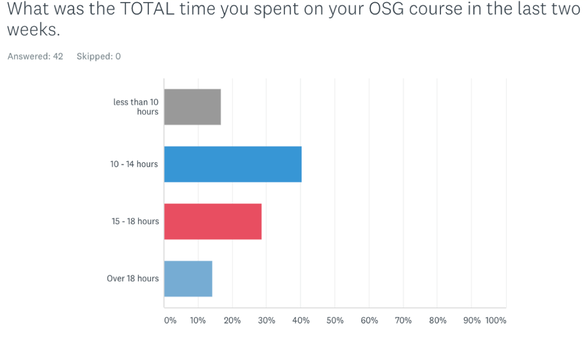 Brad Rathgeber Brad Rathgeber Looking back on the last ten years, it is easy to reflect on how much we learned early on. We learned what works well online and what doesn’t. We learned that meaningful connections between students and teachers and students with each other was possible. We also learned that there were some significant differences between the online and face-to-face learning spaces — ones that created advantages for the face-to-face classroom, and, yes, ones that created advantages for the online classroom, too. The first advantage that we found was data was plentiful in the online learning environment. We knew where students were clicking, and how they were progressing through their work. Student learning and process was more transparent. We also deliberately asked for student perceptions on their learning — regularly, and at least quarterly, as mentioned last month. Data should help you ask good questions. And, in our case, one of the first questions came in regards to an assumption that we made about time spent in online classes. The chart above is from our student survey in October 2010. We asked students how much time they had spent in their online course in the previous two weeks. We were hoping to see alignment between student time and the expectations we had set with faculty (that coursework take approximately 7-8 hours per week or 14-16 hours over a two week span). Certainly, much of what students reported was in line with this expectation. But, much of it wasn’t too… About 30% of students reported spending either less than 10 hours or more than 18 hours in their online course. We were expecting almost all students to be in one of two categories… what we got was a quick lesson that (duh!) students learn at different paces. When we dug deeper, we realized that there was no real connection between time spent and grades achieved either. That helped us come to an understanding that became an advantage of the online learning space: time was more flexible than in the classroom learning space. We learned about other advantages of learning online early on, too. This is Erissa, then a sophomore at Harpeth Hall School in Nashville. Erissa enrolled in one of our first Alpha test classes, Genetics. In late fall 2009, I travelled to Nashville with Erissa’s teacher to have conversations with administrators at Harpeth Hall, and understand their impressions of the test courses.
When we sat down with the Upper School Director, Erissa’s teacher noted how exceptional she was, telling the administrator that Erissa was the leader of her class, and that she was particularly impressive as a sophomore in a class where all other students were juniors and seniors. The Harpeth administrator thought we were mistaken: “You must be talking about Katherine or Julie?” No… we were sure, Erissa was the leader. “Erissa never says a word in class,” the administrator told us. This was our first of many lessons that the online learning space was particularly good for introverted students. Online learning spaces offered time for reflection, and for students to engage when they were ready to, instead of when the teacher wanted them to. Erissa had the time and space to reflect and engage on her terms, and thus blossomed as a leader. We’ve continued to learn and grow over the years, as we’ve reached more and different types of students -- from younger learners, to students with learning differences, to boys (yes, we did start without an all-gender division), etc.. This month, you’ll continue to hear our lessons in this regard, and learn where we’re going to continue to grow.
0 Comments
Leave a Reply. |
Don't miss our weekly blog posts by joining our newsletter mailing list below:AuthorsBrad Rathgeber (he/him/his) Archives
July 2024
Categories |



 RSS Feed
RSS Feed